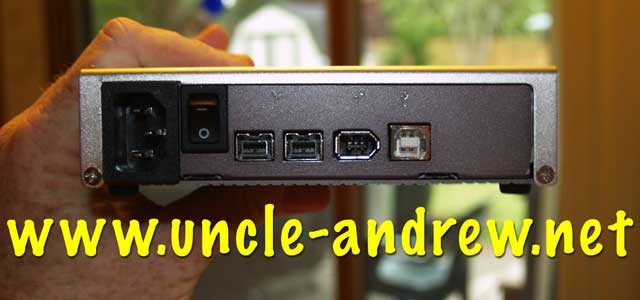My Mini-Review Of The Rocstor Pro 800AV
 Uncle Andrew
Uncle Andrew
About a month ago it finally happened: the collection of graphics, desktop publishing and Web files I have created for my employer exceeded the 100 gigabyte mark. Didn’t even get a trophy or nothin’. 😛
Up to this point I had been keeping my files on an external USB2/FireWire hard drive built around a 2.5 inch notebook drive. there are a lot of advantages to such drives: small footprint is a major one, of course, as is the fact that it draws all of its power from the USB/FireWire bus, so no additional power supply is needed. The major disadvantage, of course, is capacity. The largest notebook drives available right now top out at 160 gigabytes and costs around 250 dollars. Compare that to the current maximum of 500 gigs for a regular desktop drive, ringing in at about 300 dollars. There’s also a performance hit with the notebook drives, given the difference in rotational speed between the two; the majority of notebook drives spin at 4200–5400rpm, compared to 7200rpm for the average desktop drive. This is not a huge problem for someone with my needs, however, as I mostly plan to use the drive for backups, which makes things like rotational speed and cache size less relevant.
I decided to make the jump to a desktop drive. There are a million of them out there but I had some criteria that had to be met. First and foremost was size. Since I was going to be carrying this thing around with me, I wanted the smallest footprint possible. In this same vein, an internal power supply was a must; as any Macintosh Cube owner (such as me) can tell you, nothing ruins the sleekness of a compact device like a giant, unsightly wall wart hooked to it. Overall durability was a serious consideration as well, seeing as how I planned to drag the thing all over creation. And of course, capacity; I wanted something at least twice the capacity of my now-outdated hundred-gigger.
After considerable research, I decided on the 300 gigabyte Rocstor Pro 800AV from Rocpro.

I. Love. This. Drive. Not as much as I love my wife or gourmet ice cream or living in a Western democracy, but this is as close to that kind of love as I’m likely to get with a piece of computer equipment. It is practically everything I might have wanted in this kind of device.
The unit is about half again as large as a paperback book, and weighs just under 3 pounds. The case is aluminum all ’round, and while not terribly thick aluminum it is pretty sturdy-looking. Perphaps not quite so cast-from-a-solid-ingot-of-metal-looking as, say, the LaCie Drive designed by Porsche, but it’s as least as solid and hardly bigger, particularly considering the built-in power supply. The case is vented along the sides, so an internal cooling fan is not necessary.

It features two FireWire 800 ports, one FireWire 400 and one USB2/1.1 port, controlled by an Oxford 922 controller chip (pretty much the best controller around for 1394 devices). Inside is a Maxtor DiamondMax 10 ATA133 hard drive with a 16 megabyte cache. Using FireWire800, this drive would be an effective complement to just about any desktop system, unless you’re one of those peformance-addict types that can’t make do without a striped SATAII RAID 0….you know who you are. 😉
The drive comes with a power cord, FireWire 800, 400 and USB cables and a handy-dandy Cordura carrying case. It also comes with a couple of CDs of drivers and some backup software called Intellistor LT, though I’m not in the market for any backup software right now so I have no plans to install it and check it out.

Hard drive shown side-by-side with a nightmarish novel of demonic posession, for comparison. (Of size, by the way; not terrifying content or literary merit.)
The drive came formatted for FAT32, so I had to reformat it HFS+ for use with my Mac, but after that it worked like a charm.
I’ve said it before and I’ll say it here: I’m not a benchmark kind of guy. Installing, configuring and running a bunch of specially-contrived “real world” tests to evaluate the performance of a piece of gear seems like a waste of time to me. Particularly if said tests, however temporarily, prevent me from going about my real computer business, the business for which I bought the aforementioned gear in the first place. That being said, I think it’s safe to say that this is the fastest external drive I’ve ever owned, and this comes from someone who has owned any number of external drives from the days of SCSI 1 on up to the present. I imagine an external Serial ATA drive might be a hair quicker, but I also can’t imagine noticing the difference.
Of course, a drive of this kind of quality comes at a bit of a premium price. I paid 233 bucks for this unit at CompSource, which is about fifty to a hundred bucks more than one might expect to pay for a beige-box drive of the same capacity. It was worth it. I’d recommend this baby to anyone in the market for portable, high-capacity data storage.


